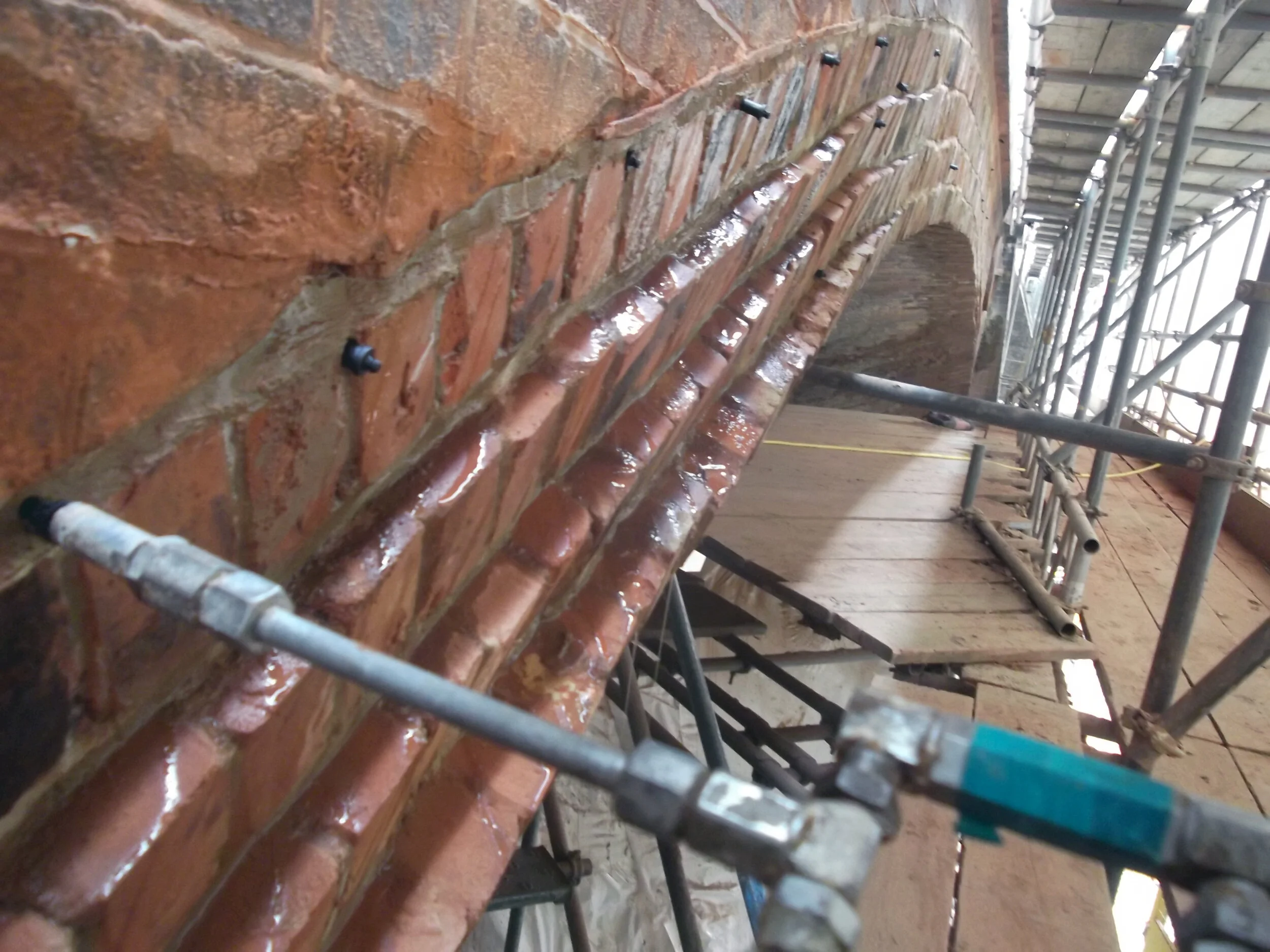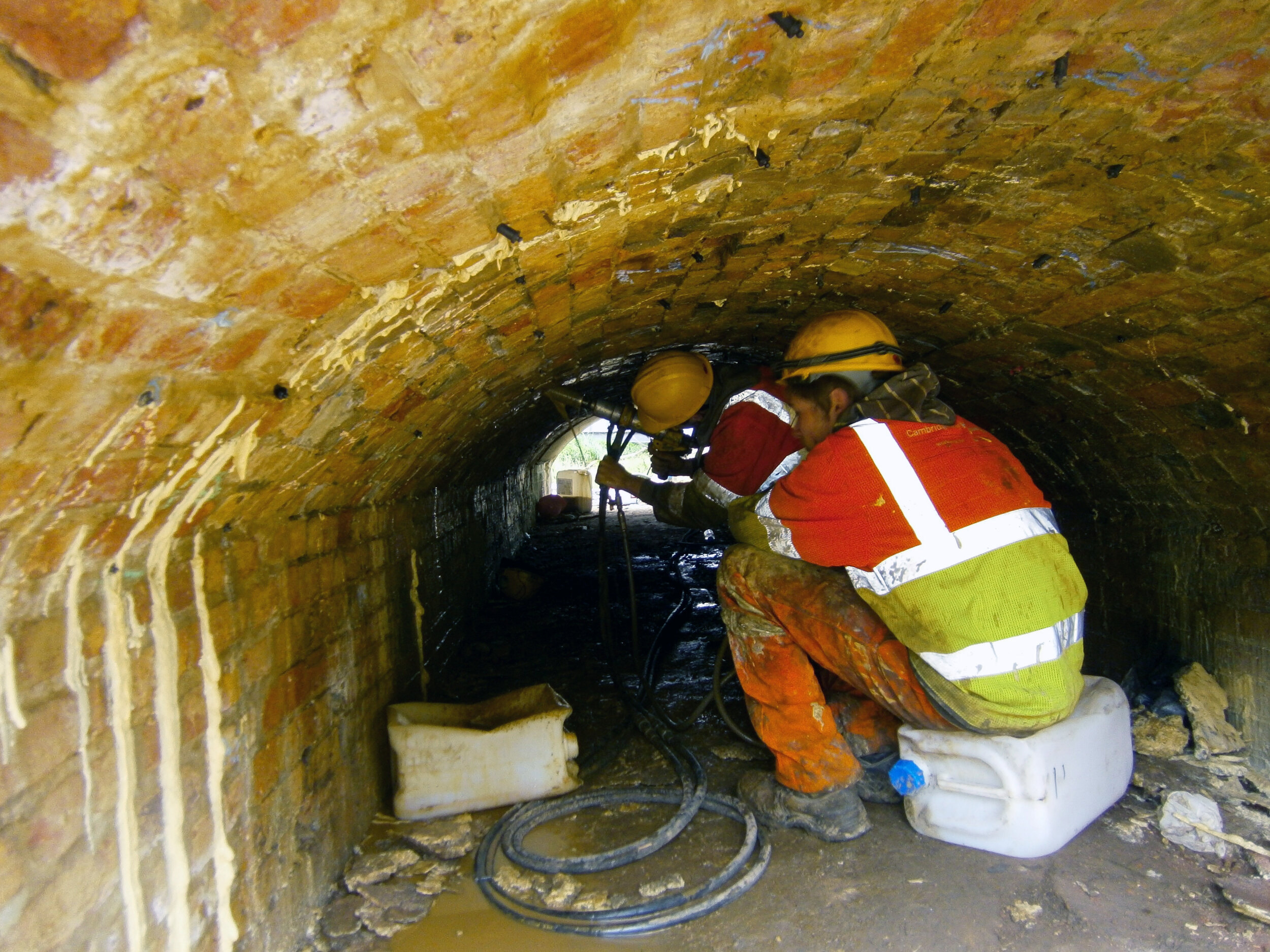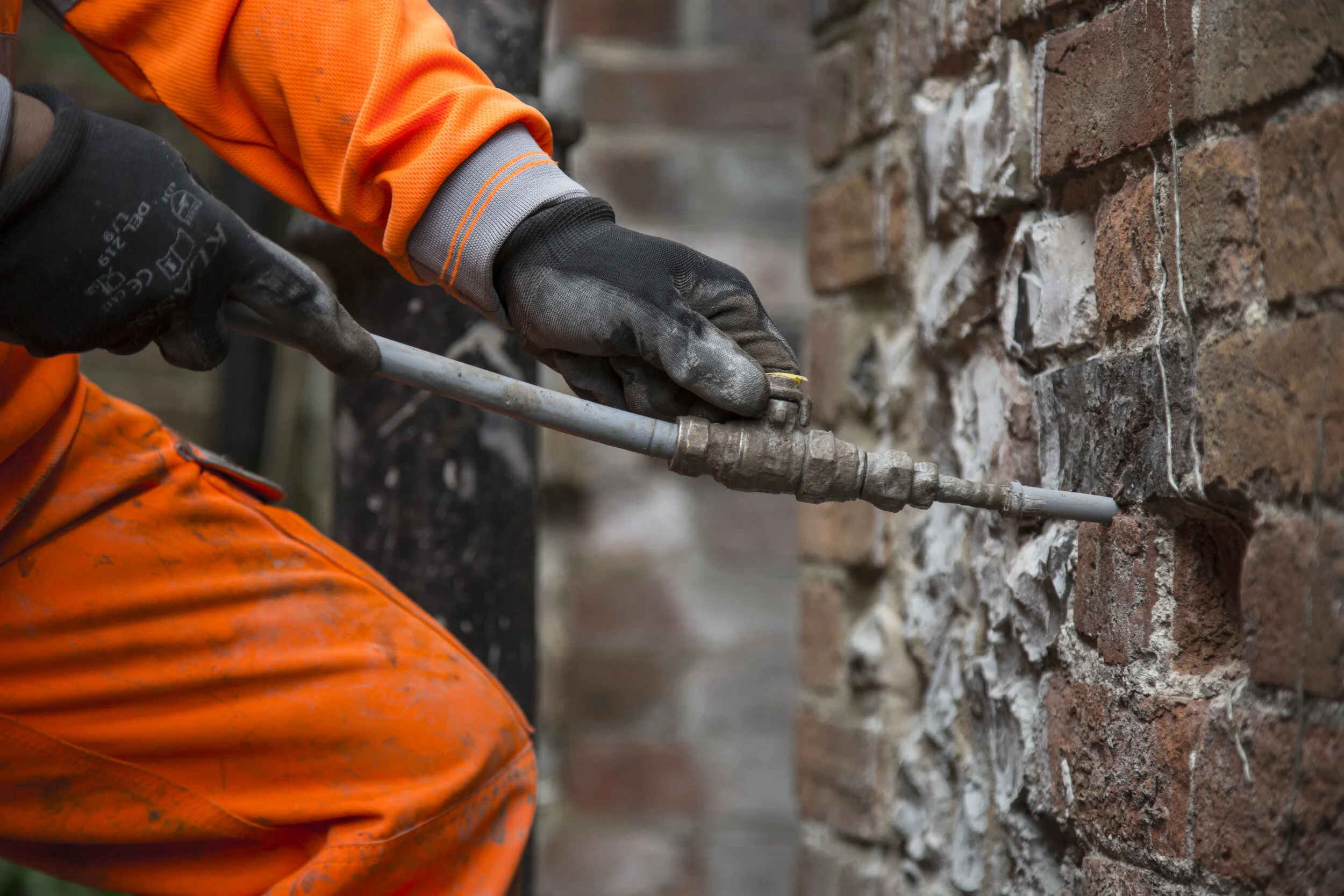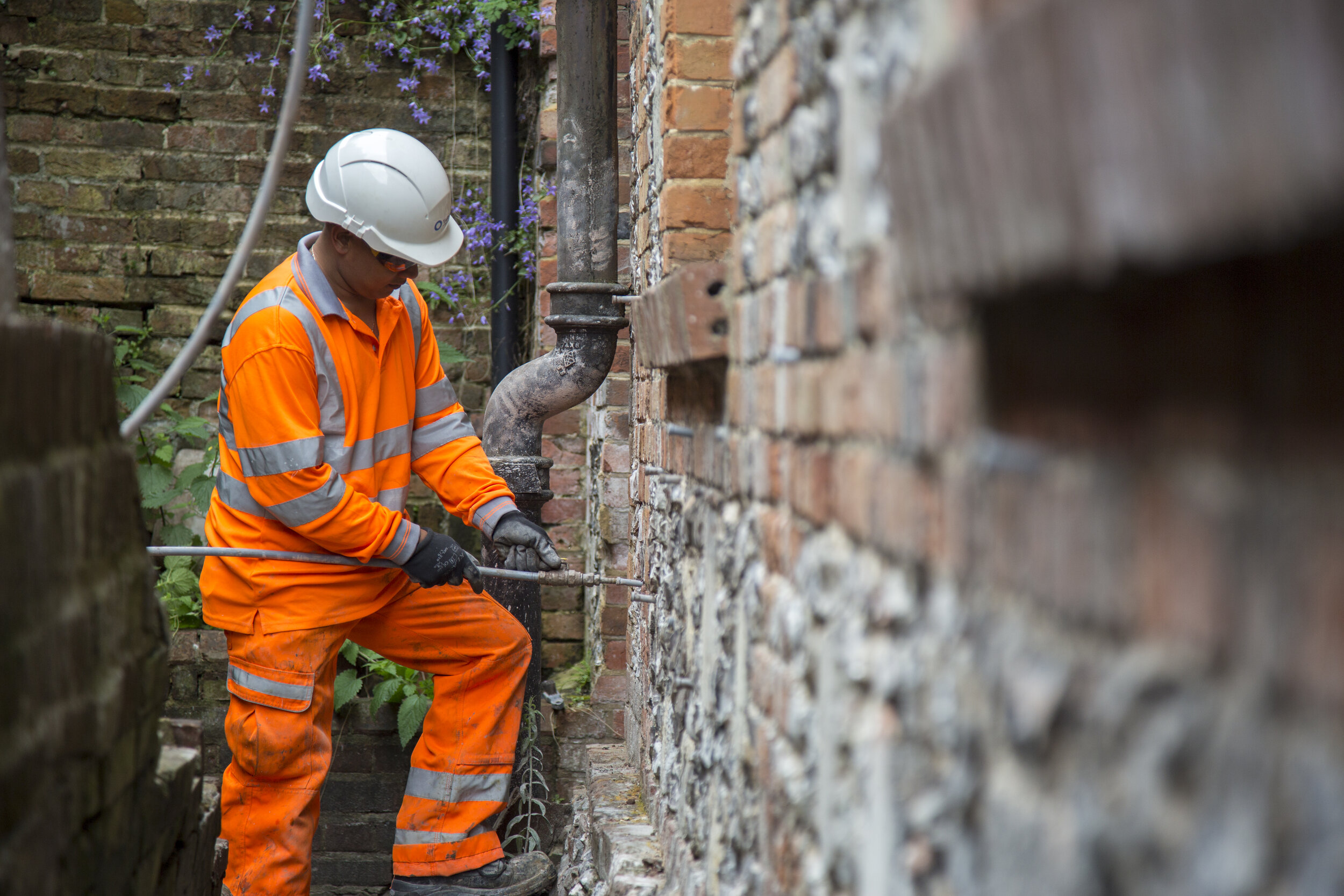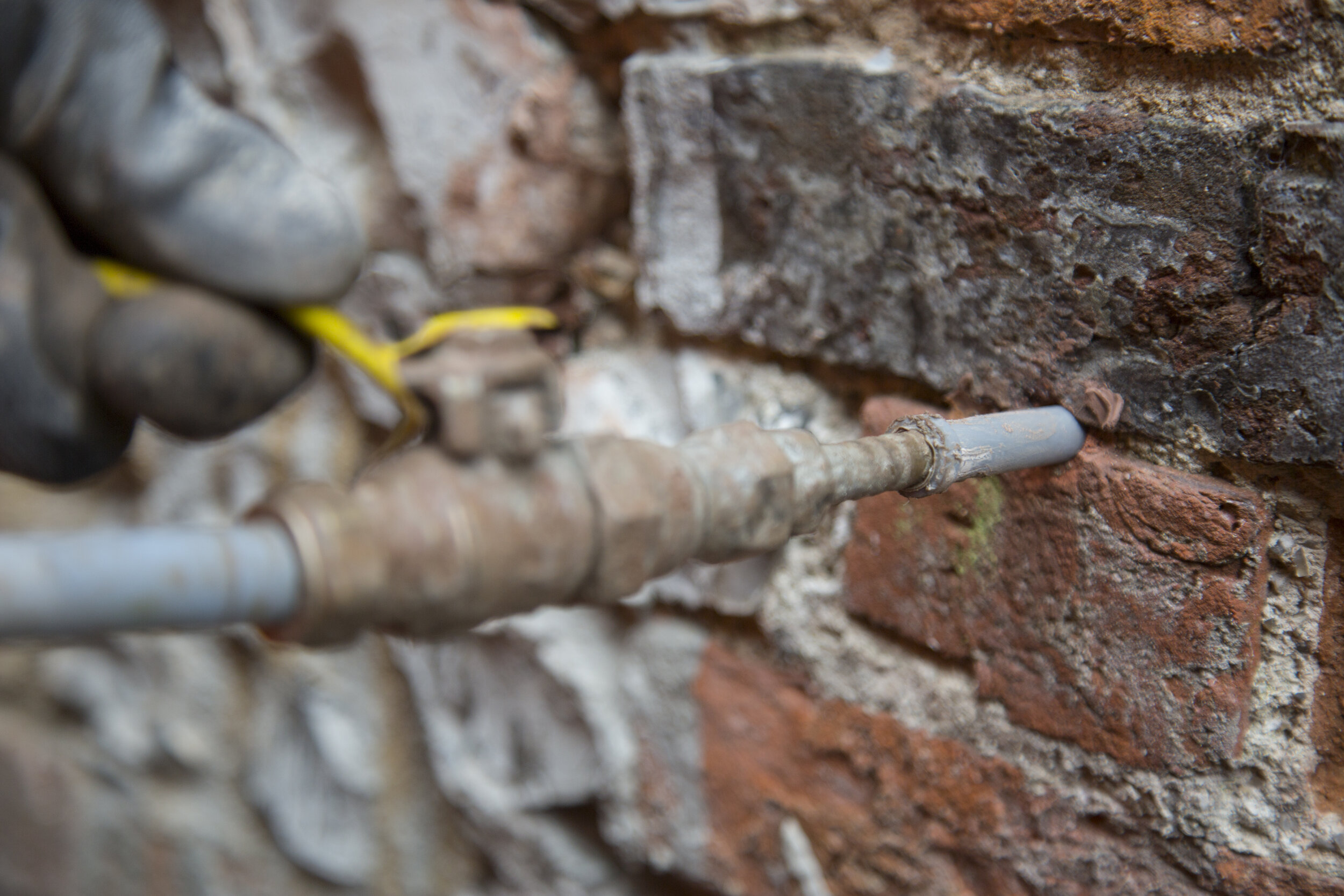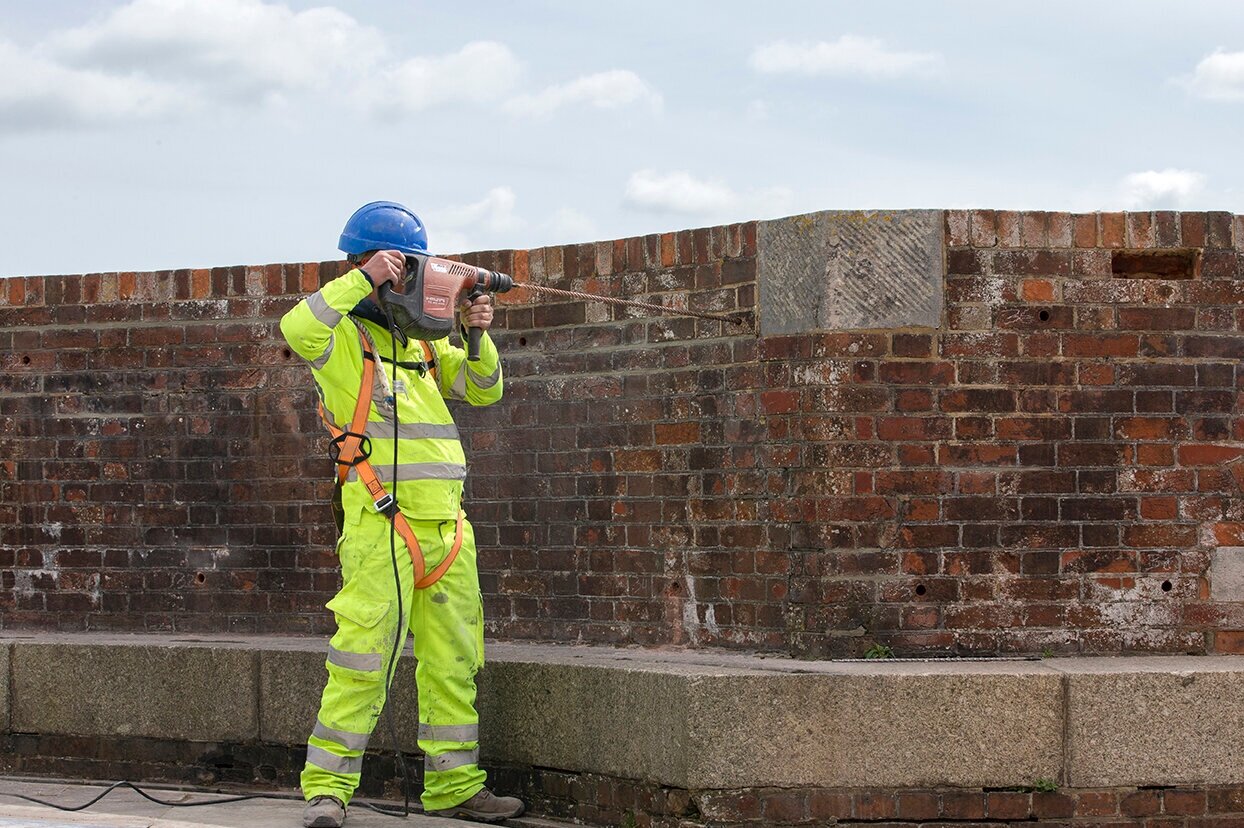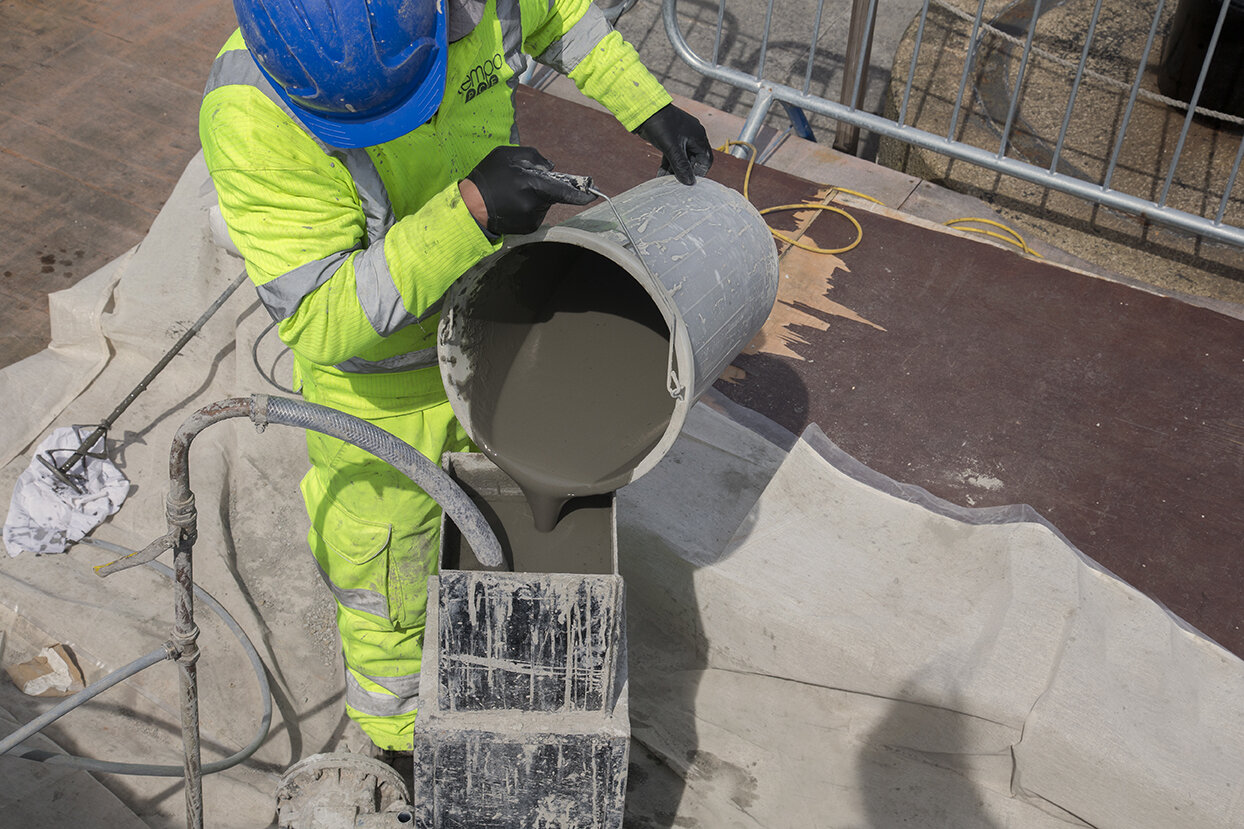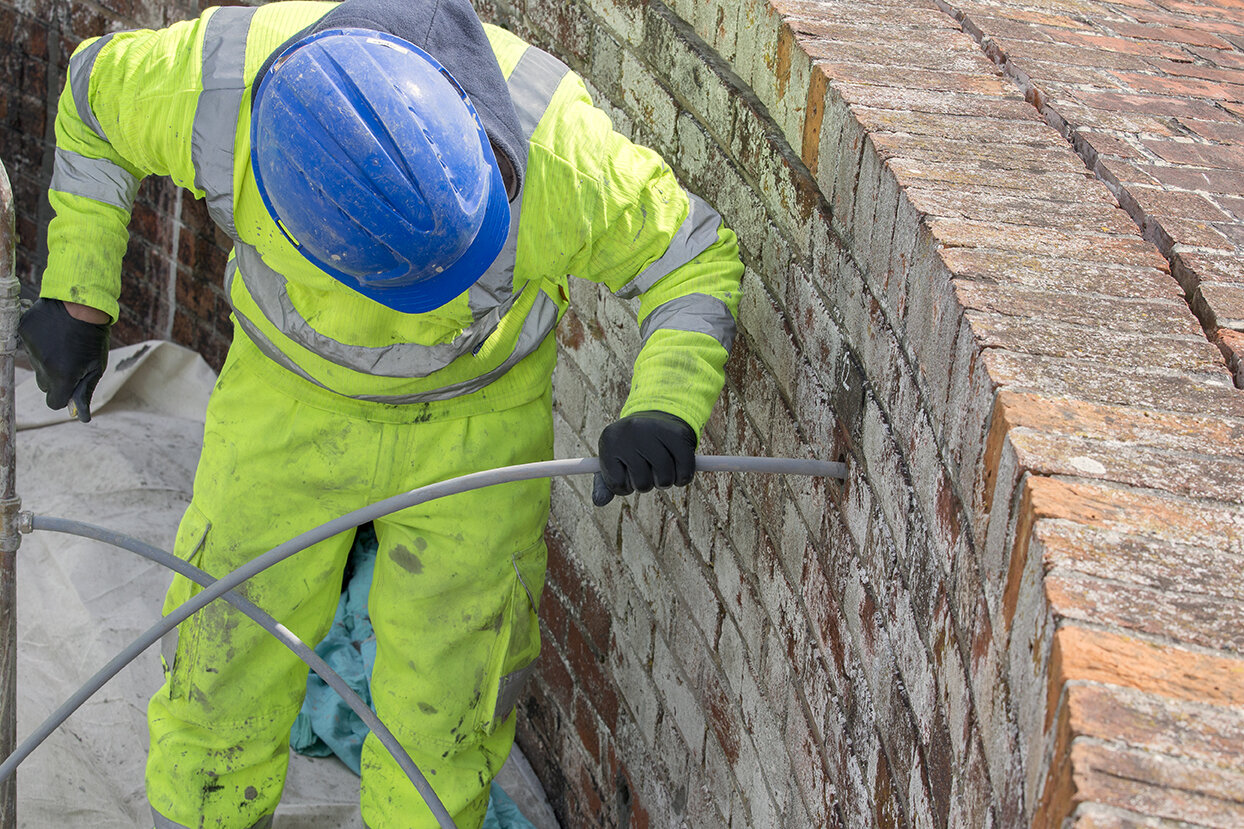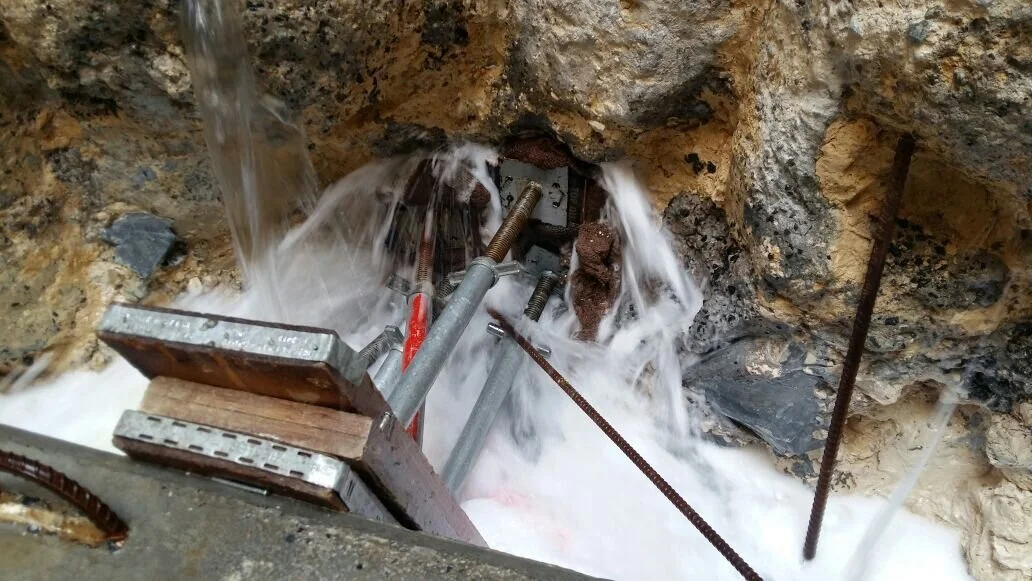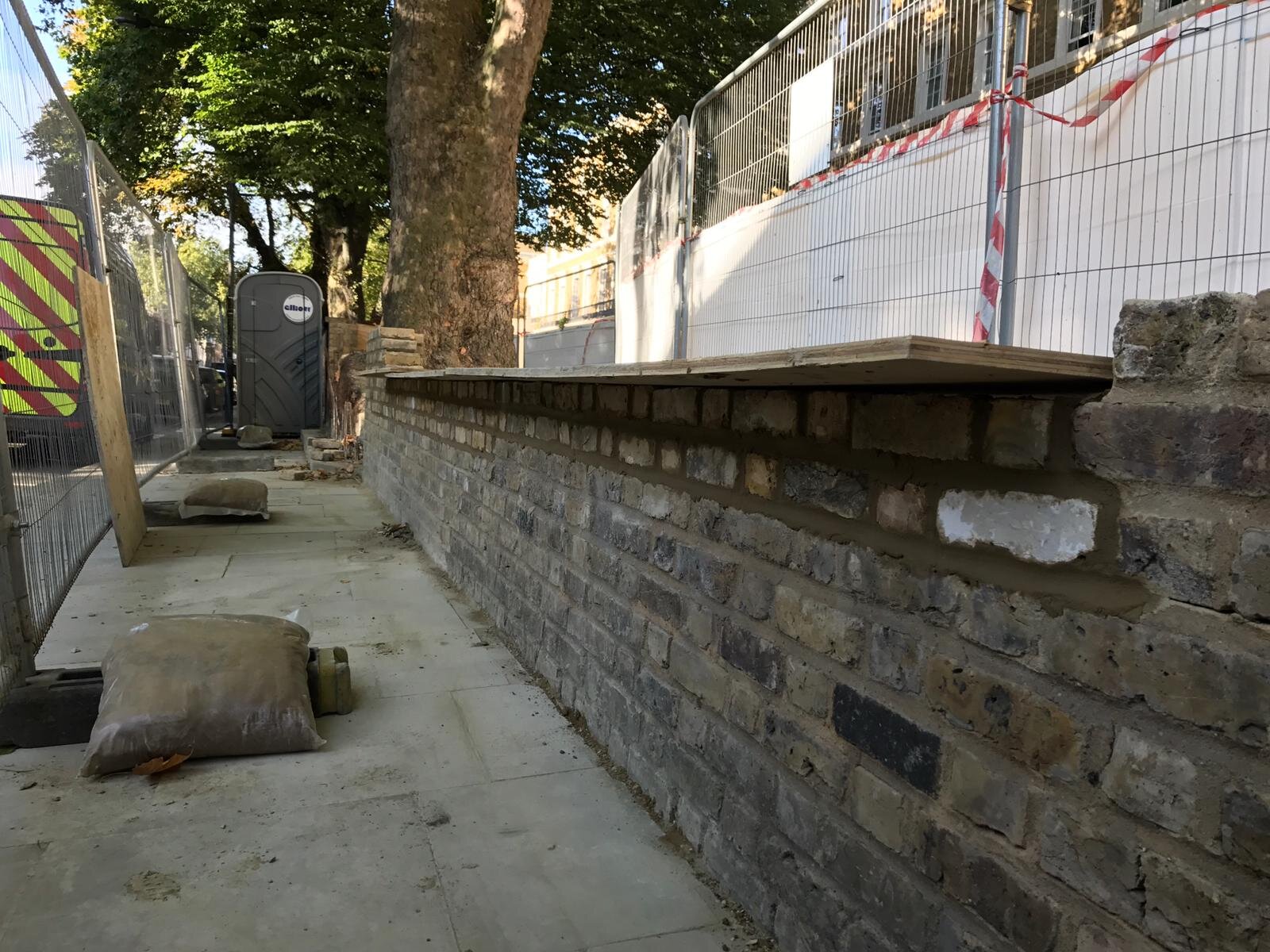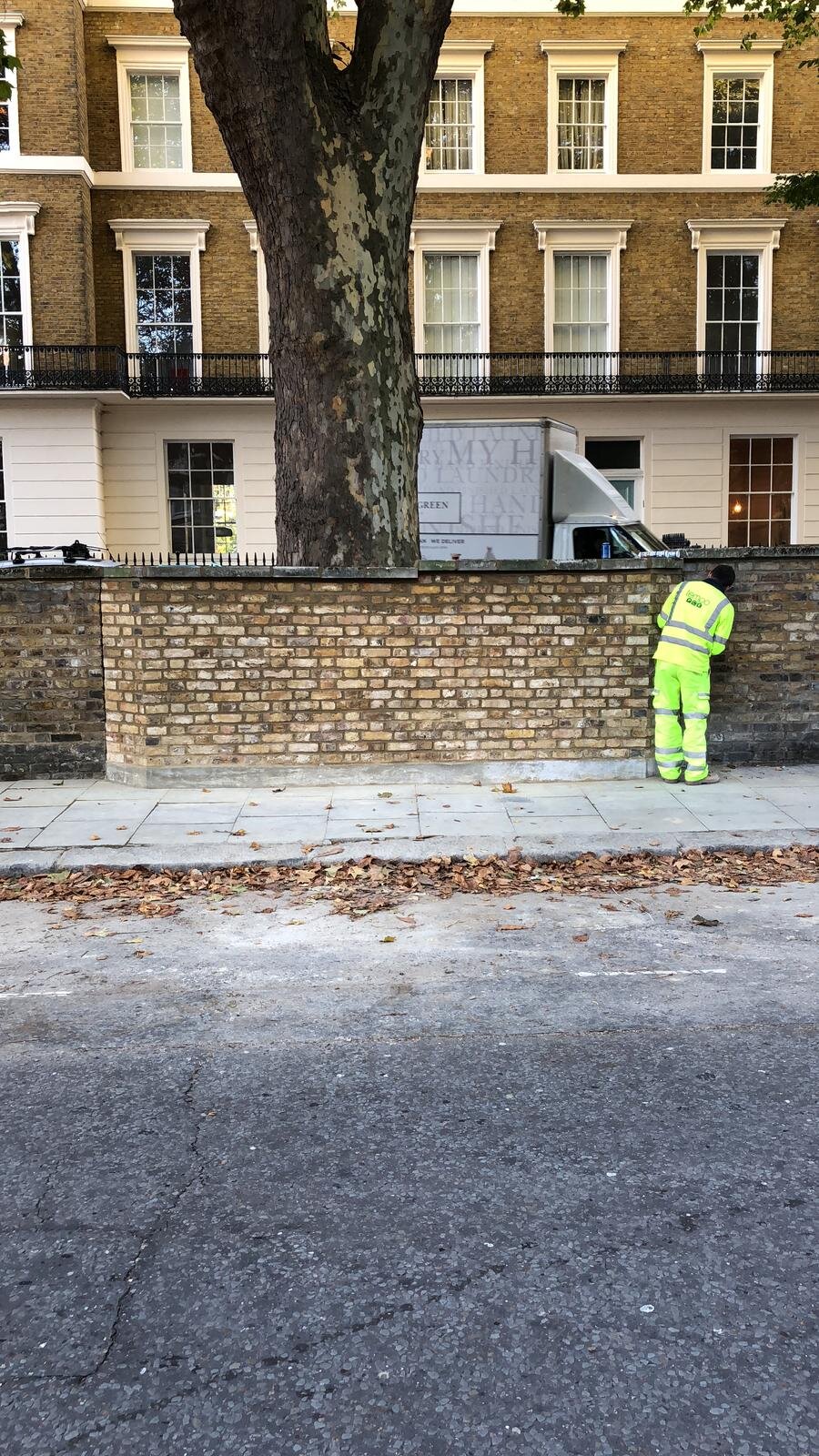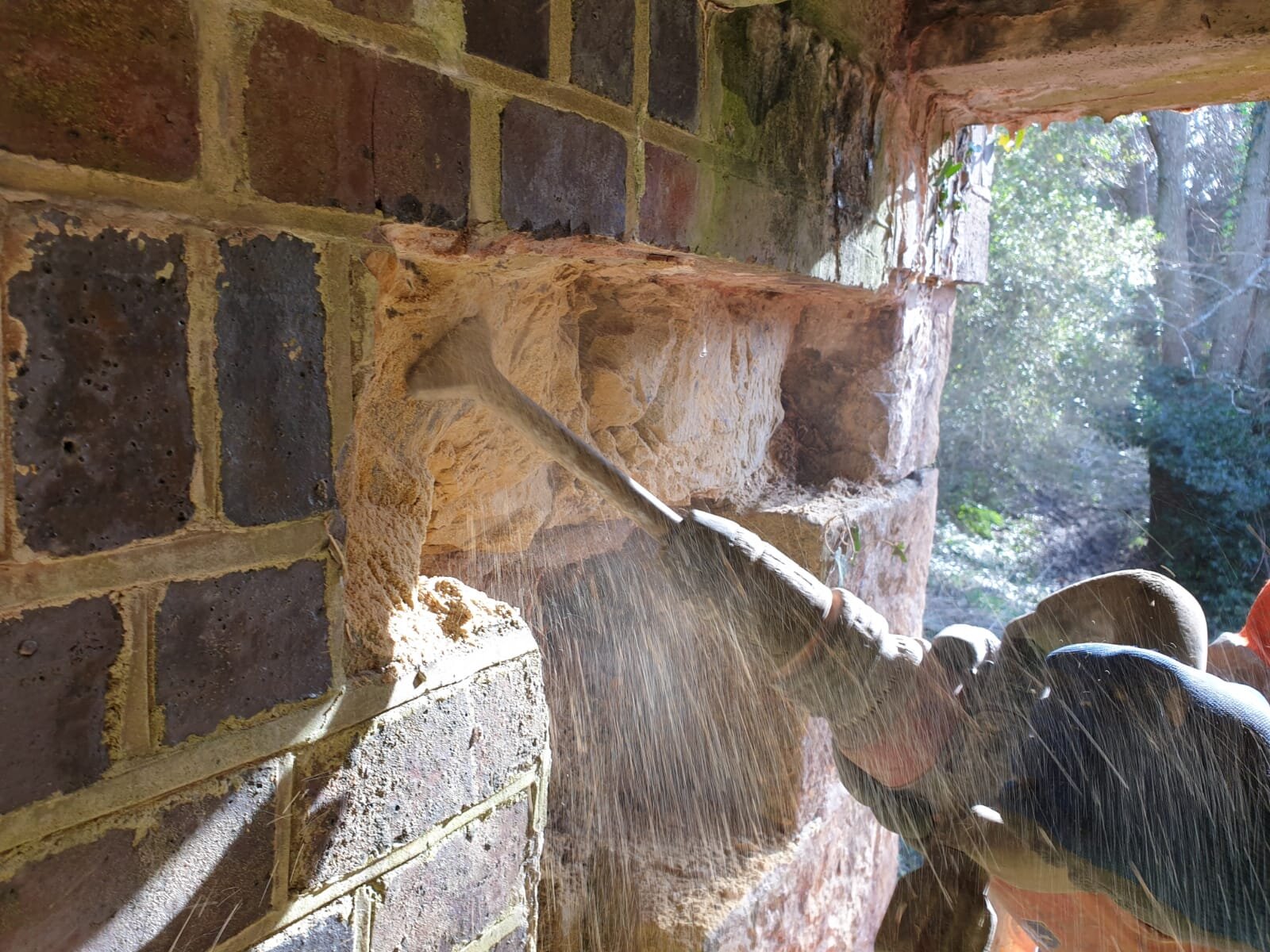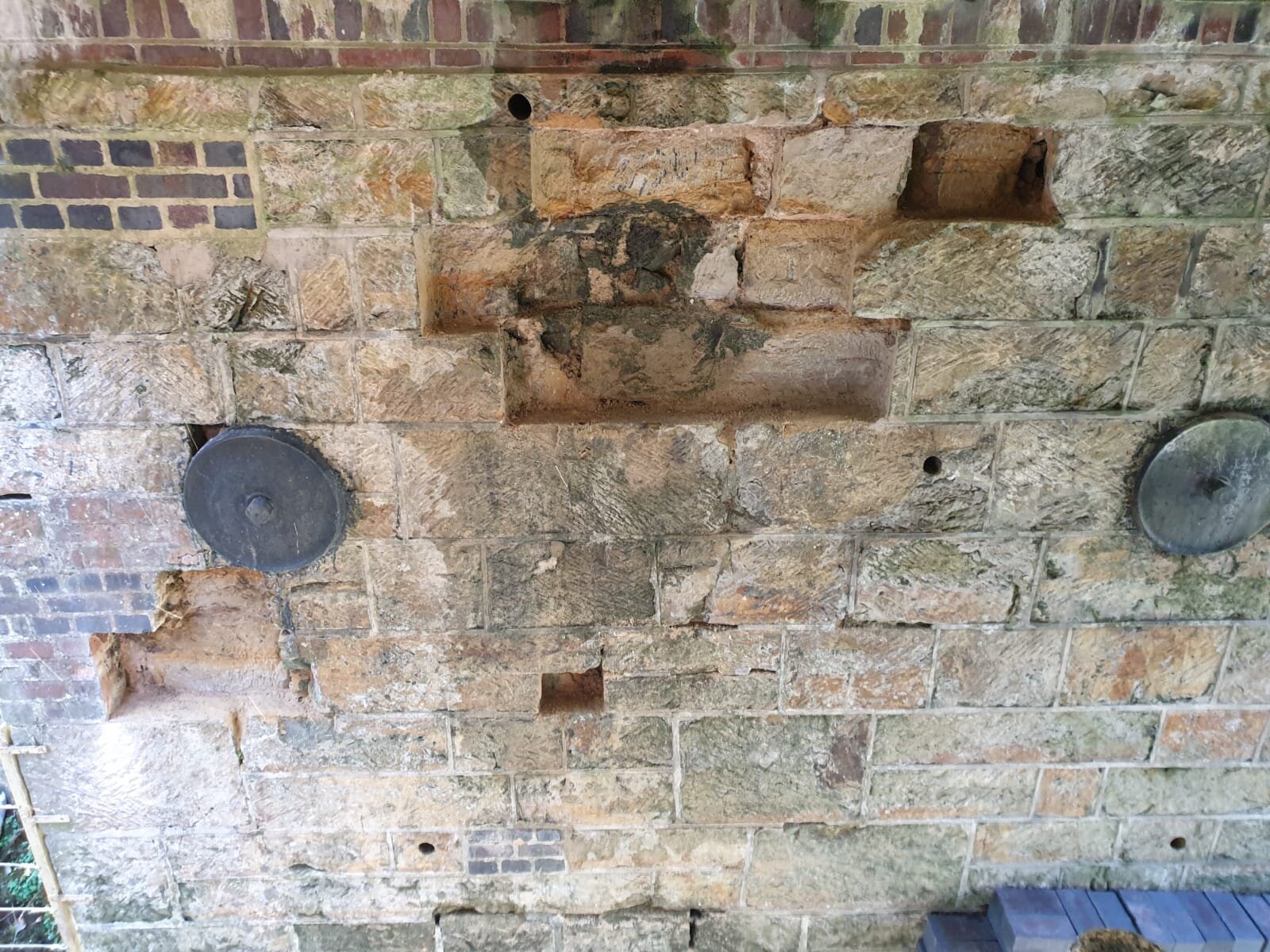
PROCESSES
Tempo-PCE offer a variety of injection and repair services. Our work methods are tailored to individual projects, taking into account the particulars of the environment and the specific requirements of a site. We offer innovative solutions for all types of masonry and concrete structures and ground conditions, and work with low and high pressure injection.
All injection quantities can be recorded with our unique mapping system for drilling and injection data. Tempo-PCE has a track record of working around existing structures and in limited access situations. Injection work can be carried out while a structure is in operation, reducing costs and disruption to the local community.
CONCRETE WATERPROOFING
Resin injection to waterproof concrete is probably the most widely used application of injection in the industry. Well-established in tunnelling, it has yet to reach its full potential in the repair and maintenance of bridges and substructures, where it can offer an economical solution to stop water ingress where other waterproofing measures have failed or, as seems to happen all too frequently, been damaged by utility works. Waterproofing injection can significantly extend the lifespan of a structure.
Typical Tunnelling Applications:
Segment tunnel crack repairs
Segment tunnel gasket repairs
SCL tunnels crack repairs
Secant pile crack repairs: horizontal/ structural or seams
Re-injectable tube systems for joints
for ground consolidation to shafts and headers please refer to Ground Engineering
PU gasket injection in a segment tunnel
Typical Bridge Applications:
Soffit repairs
Abutment repairs
Retaining wall repairs
Service tray waterproofing
Concrete waterproofing system
Cast-iron waterproofing system
Acrylic waterproofing injection to a bridge soffit
Typical Substructure Applications
Crack bonding
Delamination repair
Retaining walls, upstand/ kickers, diaphragm walls
Failed gasket joints
PU waterproofing injection in a lift shaft
Equipment & Resin Specification
Most resins can be injected using easily portable 110-volt electric pump. The most suitable resin for a concrete waterproofing or strengthening depends mostly on the nature of the leak or repair, its location, the speed of any water ingress, and the requirements for strength and flexibility.
In principle, there are four options: PUs, acrylic resin, epoxy resin, and silicate. PUs are used primarily for gasket and larger crack repairs: they cure quickly to form a semi-rigid to rigid seal. Acrylic resins are more vicious, and used to penetrate fine cracks. Epoxy resins give structural strength and can be used for waterproofing/ structural repairs, e.g. horizontal cracks in secant piles. Epoxy resins can successfully seal wet cracks without flowing water, or strengthen areas of poor quality concrete. Silicates are indicated where concrete shows damp spots without cracking. Please also see our FAQ for more details on the different resins.
Breaking out after PU injection to consolidate a heading
Service Tray Injection
Injection is particularly useful for solutions in hard-to-access or sensitive areas, for example service trays. Here, waterproofing injection avoids disruption of cables and pipes, and can link with existing waterproofing in the road deck. Resin injection allows work from beneath the soffit, with the structure remaining in full use – offering a low impact alternative to conventional methods of repair. In most cases, traffic management is unnecessary.
Acrylic gel to waterproof around services in a bridge deck
Key Benefits of Waterproofing/ Strengthening Injection
Full control of set times
Good chemical resistance against salts
Inhibits rust
Good cost control: can be reactive (spot injection)
All quantities can be measured and recorded
Bridges: Injection can be carried out above or below soffit
Retains appearance of existing structure
Works with water management, e.g. weep holes
Application Conditions & Limitations
PU resin are injected with a catalyst and will set in minutes, depending on the amount of catalyst added or the volume of water present. Set times are affected by temperature, and can be manipulated by length of hose/lances.
Acrylic resins have permanent open times until an accelerator is added, giving maximum flexibility.
Resins are affected by temperature, with cold weather conditions slowing down the reaction time.
Can be potable water safe, WRAS approved
Waterproofing injection in an underpass
Example Concrete Waterproofing Projects
LUL Finsbury Park, Spencer Group
UCLH Proton Beam Therapy, Bouygues
CrossRail (Bond St, TCR & Fisher St, Canning Town, Stepney)
Qatar Rail, Doha: Gold Line, Red Line
Elan Valley Aqueduct, Knighton, Barhale
Demark Road Tunnel, Nomenca
Bishops Avenue, Harrison Varma
Eynsham Rd Bridge, Riney
White Street, Dyer & Butler
Hale Wharf, Agility Alliance
Kingsway Tram Tunnel, Camden
MASONRY AND BACKFILL WATERPROOFING
Grout injection into masonry is at the heart of our business. Typically, we are called in to waterproof an existing brick or masonry structure where excessive water ingress has deteriorated the masonry, mortar, or backfill over time. Sometimes a waterproofing system has been compromised by utility works. Waterproofing injection is a cost-effective solution to repair deteriorated or compromised structures and to extend their life span.
A typical application involves the drilling of a grid, followed by injecting of a waterproofing resin from the bottom up, utilising gravity to aid penetration. Any voids are slowly filled, and water within the structure is pushed out. The diameter of the injection packers is usually 10mm (but can be as small as 4mm), helping to retain the visual appearance of the structure. If indicated, a second staggered grid is sometimes overlaid to ensure good coverage. Upon completion, all packers are removed, any excess resin is cleared, and the holes are carefully sealed with mortar.
Where brick repairs or pointing are required beforehand, these are carried out by our in-house bricklayer. All Tempo-PCE staff are highly experienced and Confined Space trained.
Typical Applications
Pipesubway Tunnels
Brick arch barrel bridges
Brick vaults
Brick culverts
Brick retaining walls
Drilling the injection grid
Connecting the head to the injection packer
Benefits of Waterproofing Injection
The key advantage of injection over more traditional waterproofing methods like tanking, is that it is carried out with minimal disruption and little or no traffic management.
Injection is completed from below, through the intrados, allowing road or rail traffic to run above without disruption. As the pumping of the resin is carried out at low pressure, the brickwork and backfill are not subjected to any movement. The injected resin is absorbed into the brick rings or backfill and replaces water, or air, in the structure. The resins can penetrate hairline cracks and fine capillaries in the brickwork. This is particularly the case with injection of low viscosity acrylic resins.
A further advantage is that the waterproofing of a structure achieved by injection cannot be weakened by subsequent services works, as often happens with more traditional approaches. With the manufacturer guarantees of a lifespan of 60 up to 120 years for the resins, depending on specification, waterproofing injection can considerably add to the longevity of a structure.
PU waterproofing injection and noting of quantities
Acrylic Resin for Waterproofing
The use of an acrylic resin can give a long open-time, improving absorption into the brick or backfill and giving increased flexibility over polyurethane. Acrylic resin can also be used with very short open times allowing the injector to control carefully the amount of injected material and therefore its location. This way, only specific areas can be waterproofed if required, e.g. only the brick rings. Good chemical resistance of acrylic resin helps protect highway structures against road salts.
Acrylic waterproofing injection off a raft
Backfill Waterproofing Injection
Another option is waterproofing the backfill: this allows subsequent strengthening injection of the masonry, and is particularly indicated with the masonry is in too poor condition to contain injection. A common solution is an acrylic waterproofing injection into the backfill, followed by a lime or cementitious strengthening injection into the brickwork.
Acrylic backfill injection (before strengthening injection)
Equipment & Resin Specification
Most resins can be injected using easily portable 110-volt electric pump, which is small enough to fit through a standard manhole.
A variety of acrylic or PU resins can be used for waterproofing, either on their own, or in conjunction with a structural injection process. Please also refer to Masonry Strengthening Injection, as the processes are similar and often used in conjunction. As a rough guide, waterproofing injection is carried out to the backfill or the masonry, whereas strengthening injection usually involves injecting the backfill and the structure.
Which resin is most suitable for masonry waterproofing depends on the specific requirements of the client and their structure - nature of the leak or repair, location, and requirements for strength and flexibility.
Acrylic injection through a low-pressure packer
Key Benefits
Waterproofing within brickwork
Waterproofing to backfill
Full control of setting time
Non-jacking resins
Compatible with existing water management, e.g. weep holes
Good saturation
Good chemical resistance
Appearance is retained
Quantities can be measured and recorded
Good cost control: can be used reactively, i.e. spot injection
Longevity of resin
Resins can be potable water safe/ WRAS approved
Application Conditions & Limitations
Acrylic resins have permanent open times until an accelerator is added, giving maximum flexibility.
PU is injected at the same time as the catalyst, and its set time can be controlled by the amount of the amount of catalyst added from hours to seconds, depending on project requirements
Resins are affected by temperatures, with lower temperatures slowing down reaction time
PUs become more viscous when cold, reducing penetration
Structures showing missing pointing or cracking might require either surface repair or waterproofing with the (thicker) PU to avoid material loss.
Acrylic has no structural strength, which means it can surround services and is able to be easily removed by hand if required
Example Masonry or Backfill Waterproofing Projects
Summersbury Road Bridge, Surrey
Waverley Road bridge, Barnet
Hale Lane Bridge, Barnet
Charing Cross Service Tunnel, Camden
Mill Lane Rd Bridge, Surrey
Addlestrop Cattle Creep, Dyer & Butler, Network Rail
White Cross Subway, Dyer & Butler/ Network Rail
Clarkson Hill Rd Bridge, Lancashire
Fairlee Tunnel, Newport, Isle of Wight, Island Roads
Walshaw Dean Upper Reservoir, JN Bentley/ Yorkshire Water
MASONRY STRENGTHENING INJECTION
Grout injection for masonry strengthening is Tempo-PCE’s key area of expertise. Historic structures that have deteriorated over time, maybe through lack of maintenance or excessive water ingress, can be brought back to full load capacity with strengthening injection, using a PU resin, or a cementitious grout. Works can be completed from below, minimising disruption to traffic. Strengthening injection can be carried out in conjunction with waterproofing injection, or in its own right.
PU strengthening injection to a flood defence structure
Benefits of Strengthening Injection
The key advantage of grout injection for strengthening is that the structure’s inherent flexibility is retained: the strength of the injected material is specified to suit to existing mortar, avoiding overstiffening. Alternatively, where a structure has been weakened by a lower strength mortar, e.g. lime being washed out, this can be replaced by injecting a higher strength material blend.
The process is similar as waterproofing injection, with a grid drilled, flushed, and injected from the bottom up, then cleared and sealed. Strengthening injection has the same benefits, being able to be applied from beneath the structure, allowing works to be carried out while the structure remains operational.
Typical Applications
Pipe subway Tunnels
Brick arch barrel bridges
Brick vaults
Brick culverts
Core sample showing evidence of successful latex-cement injection (white)
Equipment & Grout Specification
There are three options for strengthening grouts: PU resin, a latex-cement blend, or lime. A PU resin is indicated where the structure is relatively open, and does not have to meet historic stipulations. PUs have excellent adhesion, come in different strengths and expansion rates, and can be specified to meet specific client requirements. Shear test show that structures haven been brought back to full load capacity with our PU injection. PU resins are injected using easily portable 110-volt electric pump, which is small enough to fit through a standard manhole.
The latex-cement blend is applied with a very low-pressure via an air-driven diaphragm pump. It can link delaminated brick rings, increase brick strength, and thicken arch barrels by penetrating the backfill. It is injected. For strengthening injection with lime, please refer to Lime Grouting. All strengthening injection grouts can be used on their own, or in conjunction with a waterproofing injection beforehand.
Temporary works: radial propping to damaged brick tunnel
Key Benefits
Linking of masonry/ brick rings
Linking to existing concrete saddle
Filling of voids
Reinforcing of backfill
Good saturation of structure
Non-jacking
Good resistance to road salts
Appearance is retained
Quantities can be measured and recorded
Injection can be completed from below
Equipment can fit through manhole
Resin can be potable water safe/ WRAS approved
Application Conditions & Limitations
Any structure that has flowing water will require some injection of waterproofing grout before the cementitious (strengthening) grout is applied. The waterproofing grout must only be applied in carefully selected locations and in controlled amounts, so as not to use up spaces that will need to be injected with the strengthening material. On a typical masonry structure, localised injection of the waterproofing grout into the backfill would give temporary relief from the flowing water to enable the cementitious injection to be effective.
If substantial brick repairs are required, these should be carried out before grouting works commence to allow the new brickwork sections to be fully bonded with the existing structure.
Where there is a lot of missing pointing, this should be replaced as the grout is generally fine enough to run out through the missing pointing areas and will result in product loss.
Example Masonry Strengthening Projects
Summersbury Road Bridge, Surrey Council
Waverley Road bridge, Barnet Council
Hale Lane Bridge, Barnet Council
Northumberland Avenue Service Pipe Tunnel, FM Conway/ Westminster Council
Strand & Aldwych Service Pipe Tunnels, FM Conway/ Westminster Council
Ickleton Road Bridge, Cambridge Council
Cotterstock Road Bridge, Kier Group/ Northamptonshire Council
Byegrove Road Bridge, Merton Council
Refurbishment of Heritage Structures with Lime Injection
Lime Injection is a well-established method for the sympathetic refurbishment of historic or heritage structures. Lime injection is used for the repair and conservation of masonry structures, where the use of historic material is preferable or obligatory. A frequent application is to link delaminated masonry.
Hydraulic lime grout is injected at low pressure to avoid movement to the masonry or backfill. As the material has a low viscosity it can be injected through a 10mm probe, which are placed discretely along existing mortar lines, causing minimal effect on the appearance of the structure. Low pressure injection assists absorption, as the injected material can easily displace water or air in the structure. The grout replaces missing mortar, penetrates cracks, and fills voids.
We have used lime grout injection successfully on heritage projects like churches and cemetery walls, as well as historic road bridges.
Feeding in the injection hose
Typical Applications
Heritage structures
Historic bridges
Cemetery walls
Lime injection through the parapet
Equipment & Grout Specification
There are different options for lime grout specification, depending on the strength requirements:
Pure lime grout reaches a strength of 1 N/mm2, matching existing lime putty mortar. With heritage approval, the lime grout can have added non-cementitious blenders to increase strength and fluidity. This can be useful for heritage road bridges as it retains the natural benefits of lime, like longevity, water repelling, flexibility and self-healing, while increasing a structure’s strength: a mid-strength blender can achieve a grout equivalent of NHL 5 with 5 N/mm2 of compressive strength, a high-strength blend can reach up to 16 N/mm2 compressive strength. Note: no cements are included in the lime grout material formulations we apply.
We inject lime grout with an air-driven 1:1 ratio diaphragm pump, preventing any pressure on the substrate.
Loading the pump hopper with lime grout
Key Benefits
Ideal for heritage structures
Linking of delaminated masonry/ brick
Strengthening of structure, if required
Filling of voids
Good saturation of structure through low-pressure injection
Appearance is retained, probes can be discretely placed on mortar lines
Quantities can be measured and recorded
Non-jacking
Successful also in conjunction with acrylic waterproofing to backfill, heritage approved
Application Conditions & Limitations
Structure that show flowing water will require waterproofing injection before lime grout is applied. In this case, the waterproofing resin must be limited to srategic locations and quantities, to prevent if filling space needed for the strengthening material. On a typical masonry structure, localised injection of the waterproofing grout into the backfill will give sufficient temporary relief from flowing water to enable effective lime injection. Acrylic waterproofing grout has received Heritage approval in a number of structures into the backfill.
If substantial masonry repairs are required, these should be carried out before grouting works commence to allow the new brickwork sections to be fully bonded with the existing structure.
Any missing pointing should be replaced before injection commences to minimise loss of grout.
Example Lime Grouting Projects
Milner Hall, Winchester, The Parish of Hampshire Downs
Bugle Bridge, Monmouthshire Council
Pont Gilbert, Monmouthshire Council
Ruins Bridge, Surrey Council
Mill Lane Bridge, Surrey Council
The Langley Hotel, H.S. Dev
GOUND CONSOLIDATION & FAST LEAKS
After concrete waterproofing, ground stabilisation is the most common use of resin injection in the industry. Particularly in London, where ground works often face challenges from high ground water levels, tidal variations and heterogenous grounds, injection offers a fast, safe, and cost-effective solution to support challenging excavation and mining operations.
A typical object of stabilisation injection is temporary support to a structure, shaft or heading. Alternatively, the material can be used to fill voids, or to stop fast leaks. There is a series of suitable resin specifications, as well as different injection methods, both which have to be tailored to the specific project parameters. Some application examples:
For temporary works or to stabilise flowing sand, polyurethane (PU) is injected into the ground around a heading or shaft. The area can then be excavated safely, minimising risk of collapse. This process has successfully been applied in creating temporary piles under a scoured-out bridge foundation to give time for the main strengthening works.
Creation of a mini pile by injection of PU resin through a hollow bar. Due to the small size of the pumps, this allows access where it is not possible for a drilling rig to attend.
Use of resin injection to consolidate the ground to allow an opening to be cut into the piles/ retaining structure
Other applications include: all types of soil stabilisation, underpinning foundations and foundation stabilisation, consolidation for ground anchors, void filling, injection into saturated ground, tightening up after cement grouting, filling cavities in concrete and strata, stabilisation of cavities in tunnels, and consolidation of fractured rock, sands and gravel
Typical Applications
Shafts
Pipe connections
Headings
Tunnels
Retaining walls
Steel piles
PU injection to consolidate before header opening
Breaking out for opening of a heading to connect to a pipe
Void Filling
Void filling can be carried out by either using PU material only, or a mixture of structural polystyrene and PU only filling in gaps to the soffit. The expanded material is inert and can be removed easily if required. During injection, there is no need for structural shuttering as the material is self-supporting.
Equipment & Resin Specification
There’s a wide range of acrylic, polyurethane, and colloidal silica resins, as well as microfine cements, that can be applied for ground engineering,.
Void filling with PU
Key Benefits
Can be easily removed
Can be fireproof
Can use high or low pressure (site dependent)
Good chemical resistance
All quantities can be measured and recorded
Application Conditions & Limitations
The acrylic resins have permanent open times until an accelerator is added, giving maximum flexibility.
Polyurethane is injected at the same time as the catalyst, and will set in minutes/ seconds, depending on the amount of catalyst added.
All the acrylic and polyurethanes are affected by low temperatures, which usually slow down the reaction time.
Any structure with missing pointing or cracking likely requires either surface repair or waterproofing with the thicker polyurethane, to avoid the material loss
There is a risk of jacking
PU injection for ground consolidation at bottom of shaft
Example Ground Stabilisation/ Fast Leak Projects
Southall UTX, Barhale/ trRIIO
Tideway, Victoria Embankment, Barhale
Hiams Road bridge, Cambridgeshire Council
Denmark Road Tunnel, Nomenca
Ogden Reservoir, JN Bentley/ Yorkshire Water
DSJV for CrossRail Crossover 13, fast leaks
Qatar Doha: Qatar Rail, Gold Line, Red Line South. Fast leak sealing and head interventions
REPAIRS & INJECTION
Often a structure needs repairs as well as injection, and we can deliver a full package. While foremost injection specialists, we have a wide range of experience with brick, concrete and hybrid repairs, particularly in confined spaces. It is Tom’s experience with the refurbishment of listed and heritage buildings that lead to his interest in, and later commitment to, the injection methodology 20 years ago.
Most of our repairs are in confined spaces, using temporary works to allow a safe working environment, while the structure is in full operation, e.g. public highway above. We have also successfully carried out works off scaffold, off rafts, or over watercourses.
Typical Applications
Bridges
Tunnels
Listed structures
In conjunction with injection repairs
Example Specialist Brick Repair Projects
Gower Street Cellars, Camden
Talacre Lighthouse Flintshire
Berwick Granary Arch, English Heritage


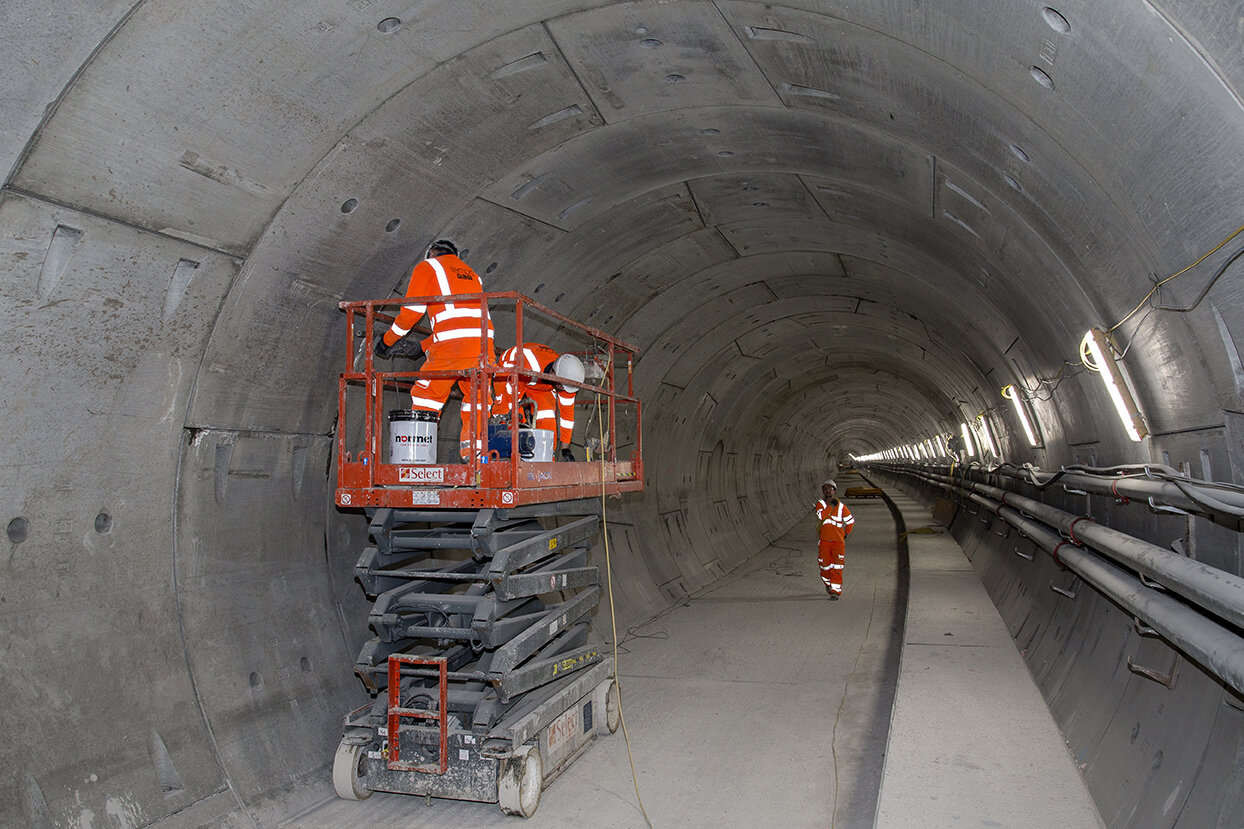













































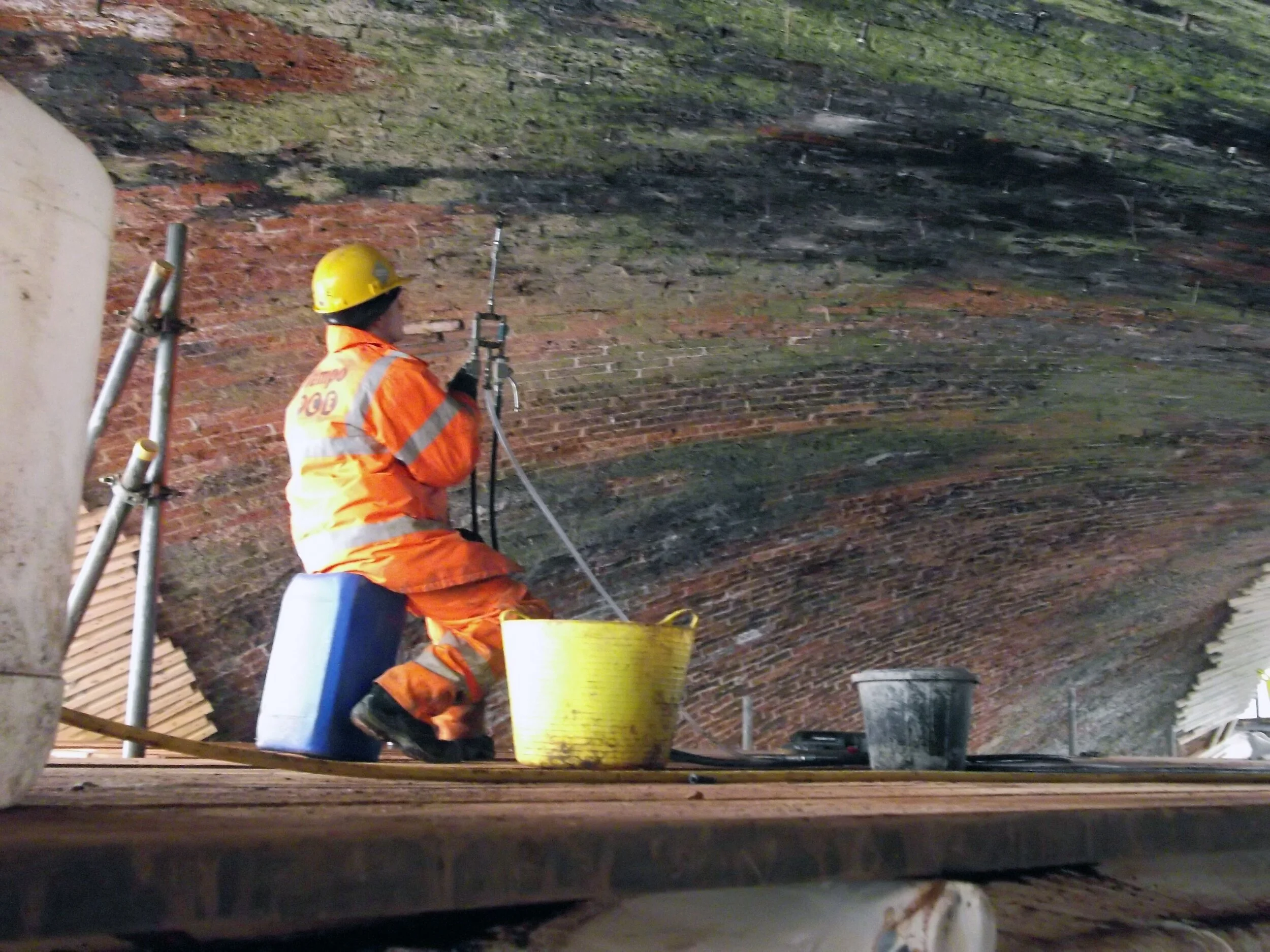



















![Drill holes along [...] in preparation for injection](https://images.squarespace-cdn.com/content/v1/5dc9d78e5e7f47509070b622/1592326113344-N34K74GZZCZ2RX9Y69KB/7dec483f-f472-4b8e-836e-79589dde775a.jpg)




